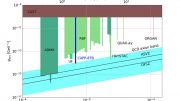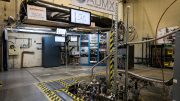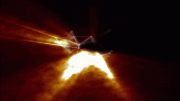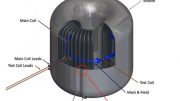
Figure 1. Cavity designs with various internal sections. (Left to right) ① single large cavity, ② single small cavity, ③ multiple small cavities ④multiple-cell cavity (pizza cavity) ⑤ multiple-cell cavity with a gap. Credit: IBS
A cavity partitioned into multiple identical cells provides a highly efficient path to high-frequency axion dark matter searches.
Despite its vanishingly tiny mass, the existence of the axion, once proven, may point to new physics beyond the Standard Model. Born to explain a fundamental symmetry problem in the strong nuclear force associated with the matter-antimatter imbalance in our Universe, this hypothetical particle also makes an attractive dark matter candidate. Though axions would exist in vast enough numbers to be able to account for the “missing” mass from the Universe, the search for this dark matter has been quite challenging so far.
Scientists believe that when an axion interacts with a magnetic field, its energy would be converted into a photon. The resulting photon is expected to be somewhere in the microwave-frequency range. Hoping to hit the right match for the axion, experimentalists use a microwave detector, a cavity haloscope. Having a cylindrical resonator placed in a solenoid, the magnetic field filling the cavity enhances the signal. The haloscope also allows scientists to continually adjust the resonant frequency of the cavity. However, the most sensitive axion-search experiment, the Axion Dark Matter eXperiment (ADMX) at the University of Washington has been searching low frequency regions, below 1 GHz, as scanning higher frequency regions requires a smaller cavity radius, resulting in significant volume loss and hence less signal. (Figure 1-②)
A research team, led by Dr. YOUN SungWoo at the Center for Axion and Precision Physics Research (CAPP) within the Institute for Basic Science (IBS) in South Korea, has developed a novel multiple-cell cavity design, dubbed “pizza cavity.” Just like pizzas are cut into several slices, multiple partitions vertically divide the cavity volume into identical pieces (cells). With almost no volume to be lost, this multiple-cell haloscope enables the meaningful output of high-frequency region scanning. (Figure 1-⑤). Though there were endeavors to bundle smaller cavities together and combine individual signals with all the cavities tuned at the same frequency, its complicated setup and non-trivial frequency matching mechanism have been bottlenecks. (Figure 1-③). “The pizza cavity haloscope features a simpler detector setup and a unique phase-matching mechanism as well as a larger detection volume compared to the conventional multi-cavity design,” notes Dr. YOUN SungWoo, the corresponding author of the study.

Figure 2. Cross-sectional view of various multiple-cell (double-, quadruple- and octuple-cell) cavities with the expected distribution of the axion-induced electric field (from simulation). Credit: IBS
The researchers proved that the multiple-cell cavity was able to detect high-frequency signals with improved efficiency and reliability. In an experiment using a 9T-superconducting magnet at a temperature of 2 kelvin (−271 °C), the team quickly scanned a frequency range of > 200 MHz above 3 GHz, which is 4~5 times higher region than that of ADMX yielding higher sensitivity to theoretical models than the previous results made by other experiments. Also this new cavity design enabled the researchers to explore a given frequency range four times faster than a conventional experiment could. “Getting things done four times faster.” Dr. Youn jokingly adds, “Using this multiple-cell cavity design, our Ph.D. students should be able to graduate faster than those in other labs.”
What makes this multiple-cell design simple to operate is the gap between partitions in the middle. Having all of the cells spatially connected, a single antenna picks up the signal from the entire volume. “As a pizza saver keeps pizza slices intact with its original toppings, the gap in between helps the cells to be up to the job,” says Dr. Youn. The single antenna also allows researchers to assess whether the axion-induced electromagnetic fields are evenly distributed throughout the cavity, which is found to be critical to achieve the maximum effective volume. “Still, the inaccuracy and misalignment in cavity construction could hamper the sensitivity. For that, this multiple-cell design enables to relieve it by adjusting the size of the gap in the middle, leaving no volume to go to waste,” explains Dr. Youn.
The two-year extensive efforts of the research team resulted in an optimal design for long-sought search of axion dark matter in high-frequency regions. The team is looking into incorporating several multiple-cell cavities onto the existing systems at CAPP to extend the axion search band to higher-frequency regions than currently explored.
Reference: “Search for Invisible Axion Dark Matter with a Multiple-Cell Haloscope” by Junu Jeong, SungWoo Youn, Sungjae Bae, Jihngeun Kim, Taehyeon Seong, Jihn E. Kim and Yannis K. Semertzidis, 25 November 2020, Physical Review Letters.
DOI: 10.1103/PhysRevLett.125.221302









Wetenschap lijkt steeds meer op een kerkgenootschap.
Stop met geloven maar toon aan!
Op basis van een natuurwet is aan te tonen dat donkere materie niet detecteer baar is.
Zie mijn reactie op artikel van Nemo kennislink met als titel: ‘God zonder oordeel of liefde’.